Using a patterned microtexture to reduce polyethylene wear in metal-on-polyethylene prosthetic bearing couples
- PMID: 29358840
- PMCID: PMC5774990
- DOI: 10.1016/j.wear.2017.09.014
Using a patterned microtexture to reduce polyethylene wear in metal-on-polyethylene prosthetic bearing couples
Abstract
The longevity of metal-on-polyethylene prosthetic hip joint bearings, in which a CoCrMo femoral head articulates with a polyethylene liner, is often limited by polyethylene wear and osteolysis caused by polyethylene wear particles. Current approaches to reduce polyethylene wear include improving the mechanical properties of the polyethylene liner, and/or manufacturing ultra-smooth articulating surfaces. In contrast, this experimental work shows that adding a patterned microtexture of concave "dimples" to a polished CoCrMo surface significantly reduces polyethylene wear by promoting the formation of an elastohydrodynamic lubricant film, which reduces contact between the CoCrMo and polyethylene bearing surfaces. Using a gravimetric method to measure polyethylene pin wear during pin-on-disc experiments, it was demonstrated that microtextured CoCrMo caused reduced polyethylene wear compared to polished CoCrMo surfaces. Wear was quantified for different polyethylene materials currently used in commercial prosthetic hip joint bearings, and for several microtexture geometries. It was also documented by correlating polyethylene wear with surface topography measurements that the patterned microtexture reduced contact between the articulating bearing surfaces.
Figures





Similar articles
-
Microtextured CoCrMo alloy for use in metal-on-polyethylene prosthetic joint bearings: multi-directional wear and corrosion measurements.Tribol Int. 2018 Aug;124:178-183. doi: 10.1016/j.triboint.2018.04.007. Epub 2018 Apr 9. Tribol Int. 2018. PMID: 30778273 Free PMC article.
-
Friction between a polyethylene pin and a microtextured CoCrMo disc, and its correlation to polyethylene wear, as a function of sliding velocity and contact pressure, in the context of metal-on-polyethylene prosthetic hip implants.Tribol Int. 2018 Nov;127:568-574. doi: 10.1016/j.triboint.2018.07.005. Epub 2018 Jul 4. Tribol Int. 2018. PMID: 30778274 Free PMC article.
-
A patterned microtexture to reduce friction and increase longevity of prosthetic hip joints.Wear. 2014 Jul 15;315(1-2):51-57. doi: 10.1016/j.wear.2014.04.001. Wear. 2014. PMID: 25013240 Free PMC article.
-
Surface Texturing of Prosthetic Hip Implant Bearing Surfaces: A Review.J Tribol. 2021 Apr 1;143(4):040801. doi: 10.1115/1.4048409. Epub 2020 Oct 5. J Tribol. 2021. PMID: 34168396 Free PMC article. Review.
-
Bearing surfaces for total disc arthroplasty: metal-on-metal versus metal-on-polyethylene and other biomaterials.Spine J. 2012 Aug;12(8):693-701. doi: 10.1016/j.spinee.2011.05.008. Epub 2011 Jun 22. Spine J. 2012. PMID: 21700505 Review.
Cited by
-
Microtextured CoCrMo alloy for use in metal-on-polyethylene prosthetic joint bearings: multi-directional wear and corrosion measurements.Tribol Int. 2018 Aug;124:178-183. doi: 10.1016/j.triboint.2018.04.007. Epub 2018 Apr 9. Tribol Int. 2018. PMID: 30778273 Free PMC article.
-
The Effect of Texture Floor Profile on the Lubricant Film Thickness in a Textured Hard-On-Soft Bearing With Relevance to Prosthetic Hip Implants.J Tribol. 2021 Feb 1;143(2):021801. doi: 10.1115/1.4047753. Epub 2020 Aug 3. J Tribol. 2021. PMID: 34168395 Free PMC article.
-
Study of the tribological properties of surface structures using ultrashort laser pulses to reduce wear in endoprosthetics.J Orthop Surg Res. 2020 Jun 3;15(1):205. doi: 10.1186/s13018-020-01719-1. J Orthop Surg Res. 2020. PMID: 32493446 Free PMC article.
-
Maximizing the Lubricant Film Thickness Between a Rigid Microtextured and a Smooth Deformable Surface in Relative Motion, Using a Soft Elasto-Hydrodynamic Lubrication Model.J Tribol. 2020 Jul 1;142(7):071802. doi: 10.1115/1.4046291. Epub 2020 Mar 11. J Tribol. 2020. PMID: 34168394 Free PMC article.
-
Friction between a polyethylene pin and a microtextured CoCrMo disc, and its correlation to polyethylene wear, as a function of sliding velocity and contact pressure, in the context of metal-on-polyethylene prosthetic hip implants.Tribol Int. 2018 Nov;127:568-574. doi: 10.1016/j.triboint.2018.07.005. Epub 2018 Jul 4. Tribol Int. 2018. PMID: 30778274 Free PMC article.
References
-
- Foran JRH. Website of the American Academy of Orthopaedic Surgeons. August 2015 [Online] Available: http://orthoinfo.aaos.org/topic.cfm?topic=A00377 [Accessed 11 April 2017]
-
- Kurtz S, Mowat F, Ong K, Chan N, Lau E, Halpern M. Prevalence of primary and revision total hip and knee arthroplasty in the United States from 1990 through 2002. J Bone Joint Surg Am. 2005;87:1487–1497. - PubMed
-
- Dumbleton J. Wear and its measurement for joint prosthesis materials. Wear. 1978;49(2):297.
-
- Cooper J, Dowson D, Fisher J. Macroscopic and microscopic wear mechanisms in ultra-high molecular weight polyethylene. Wear. 1993;378:162–164.
-
- Fisher J. Wear of ultra-high molecular weight polyethylene in total artificial joints. Curr Orthop. 1994;8(3):164.
Grants and funding
LinkOut - more resources
Full Text Sources
Other Literature Sources
